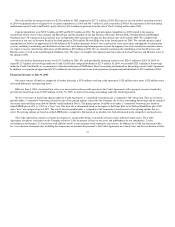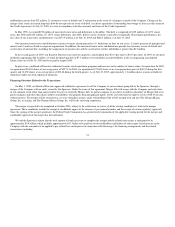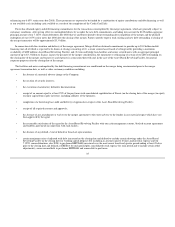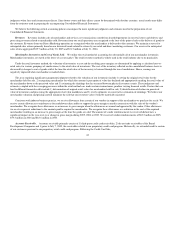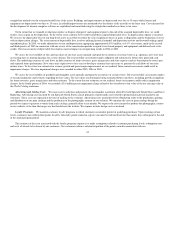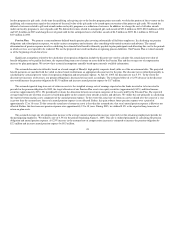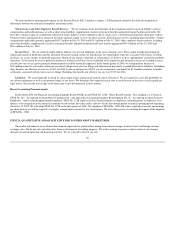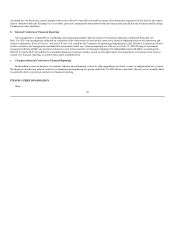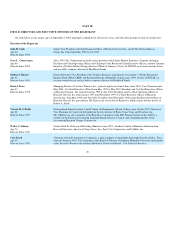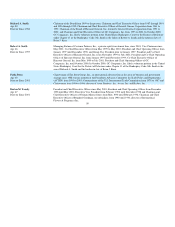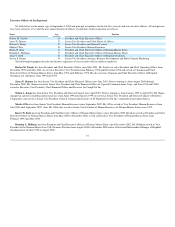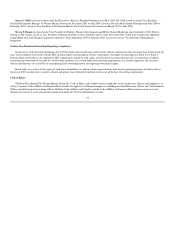Neiman Marcus 2004 Annual Report Download - page 46
Download and view the complete annual report
Please find page 46 of the 2004 Neiman Marcus annual report below. You can navigate through the pages in the report by either clicking on the pages listed below, or by using the keyword search tool below to find specific information within the annual report.
HSBC will extend credit to customers under our proprietary credit card arrangements under the Neiman Marcus and Bergdorf Goodman brand names.
Prior to the Credit Card Sale. Prior to the Credit Card Sale, our proprietary credit card arrangements generated finance charge income, which was
recognized as income when earned and was recorded as a reduction of selling, general and administrative expenses. In addition, we maintained reserves for
potential credit losses by evaluating the collectibility of our accounts receivable based on a combination of factors, including analysis of historical trends,
aging of accounts receivable, write-off experience and expectations of future performance. Net finance charge income recognized in 2005 prior to the Credit
Card Sale was $69.4 million.
We securitized our proprietary credit card program in September 2000 pursuant to a revolving Credit Card Facility whereby we transferred substantially
all of our credit card receivables to a qualifying trust. At the inception of the Credit Card Facility, the trust issued certificates representing undivided interests
in the credit card receivables in the face amount of $225.0 million to third-party investors (Sold Interests). We held certificates (Retained Interests)
representing the excess of the credit card receivables over the Sold Interests. Prior to December 2003, the monthly transfers to the trust related to the Sold
Interests qualified to be accounted for as sales (Off-Balance Sheet Accounting). As a result, we removed the $225.0 million of credit card receivables sold
from our balance sheet at the inception of the credit card securitization facility and our $225.0 million repayment obligation to the holders of the certificates
representing the Sold Interests was not required to be shown as a liability on our consolidated balance sheet. During the period of Off-Balance Sheet
Accounting, we recognized, as a reduction to selling, general and administrative expenses, the income we earned pursuant to the Credit Card Facility
consisting primarily of gains on the monthly transfers of new receivables to the trust related to the Sold Interests, income on our Retained Interests and service
fee income.
Beginning in December 2003, our subsequent transfers to the Trust ceased to qualify for Off-Balance Sheet Accounting. Rather, credit card receivables
transferred to the Trust after November 2003 remained on our balance sheet and were recorded as secured borrowings. From December 2003 until the date of
the Credit Card Sale, our entire credit card portfolio were included in accounts receivable and the outstanding borrowings under the credit card securitization
facility were shown as a liability in our consolidated balance sheet.
Beginning in April 2005, cash collections were used by the Trust to repay the $225.0 million principal balance of the Class A Certificates in monthly
installments of $37.5 million.
Subsequent to the Credit Card Sale. On July 7, 2005, HSBC purchased our approximately three million private label Neiman Marcus and Bergdorf
Goodman credit card accounts and related assets, as well as the outstanding balances associated with such accounts. The total purchase price was
approximately $647 million, consisting of approximately $534 million in net cash proceeds and the assumption of approximately $113 million of outstanding
debt under our revolving credit card securitization facility. We recognized a gain of $6.2 million in connection with the sale of our credit card portfolio to
HSBC.
As a part of the Credit Card Sale, we entered into a long-term marketing and servicing alliance with HSBC. Under the terms of this alliance, HSBC
offers credit cards and non-card payment plans bearing our brands and we receive from HSBC ongoing payments related to credit sales and compensation for
marketing and servicing activities. In addition, we continue to handle key customer service functions, initially including new account processing, most
transaction authorization, billing adjustments, collection services and customer inquiries. We record the HSBC Program Income as a reduction of selling,
general and administrative expenses. Such amounts aggregated $2.2 million in 2005.
Long-lived Assets. Property and equipment are stated at historical cost less accumulated depreciation. For financial reporting purposes, we compute
depreciation principally using the
43


